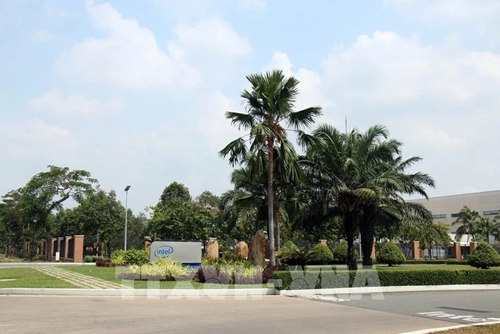A major milestone in its development came in 2006 when Intel invested 1 billion USD to open a manufacturing facility at the SHTP. This plant is expected to hit the milestone of four billion units shipped by April, underscoring its vital role in Intel’s global supply chain.
    |
 |
|
Intel’s factory area, a major investor at Saigon Hi-Tech Park in Ho Chi Minh City |
Intel’s sustained presence, along with that of over 10 other global high-tech firms, including Samsung, Nidec, Jabil, and Rockwell Automation, has firmly placed the SHTP on the international investment map. To date, the SHTP hosts 160 valid investment projects with a total capital of over 12.3 billion USD, including 10.3 billion USD in FDI.
Exports from the park have surged dramatically, from just 500 million USD in 2010 to over 20.7 billion USD in 2024. Cumulative export value has reached 161.9 billion USD, while total output of high-tech products is estimated at over 170 billion USD.
Vice Chairman of the Ho Chi Minh City People’s Committee Vo Van Hoan emphasized that the presence of strategic investors like Intel reflects Vietnam’s appeal and strong potential in the high-tech sector, especially in semiconductors and electronics.
The city possesses a well-developed ecosystem with a skilled engineering workforce and policies that support industrial development in emerging fields like AI, precision mechanics, and biotech.
Alongside attracting foreign tech giants, the SHTP is also nurturing domestic innovation. Vietnamese companies such as FPT, Nanogen, and Gremsy are active investors in the park, while a growing number of overseas Vietnamese entrepreneurs and scientists have also launched projects in semiconductors, aerospace, and automation.
The SHTP’s Hi-Tech Business Incubator has supported 131 startups, including Gremsy, which has successfully exported drone technology to over 40 countries. The incubator model aligns with the park’s broader strategy to support Vietnamese enterprises in adopting, developing, and commercializing advanced technologies.
In 2024, the Prime Minister approved a plan to expand the SHTP as part of the Southeastern Region Development Plan. The goal is to transform the park into a full-fledged science and technology park with optimal conditions for R&D, tech incubation, and commercialization.
This direction is supported by the recent Resolution No.57-NQ/TW of the Politburo, which calls for breakthroughs in science, innovation, and national digital transformation.
According to deputy head of the SHTP Le Quoc Cuong, the resolution provides a roadmap for the park’s sustainable development and reinforces science and technology as the foundation of economic restructuring.
To build endogenous capacity, the SHTP is pursuing a strategy that balances foreign investment with technology transfer, R&D expansion, and the incubation of local startups. By 2025, the park targets R&D spending to reach 250 million USD, which would account for 47% of private R&D expenditure in Ho Chi Minh City and 7% nationwide.
High-tech supporting industries are also expanding, with 26 projects now contributing to the supply chain. Local content in production has increased significantly, from just 6–8% in 2011–2012 to 26% in 2013, and has averaged 20% annually since then. The park aims to reach 35% localization by 2025.
In the coming time, the SHTP will prioritize FDI from developed countries such as the U.S., Japan, and E.U. members, as well as from emerging economies with strong tech industries. Domestic projects, especially those from well-funded startups and science-tech enterprises, will also be supported to deepen Vietnam’s innovation capacity.
With over two decades of development, the SHTP has become a key destination for global tech firms and is now poised to drive Vietnam’s technological self-reliance and industrial advancement in the new era.
Source: VNA